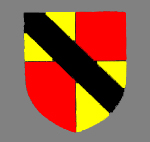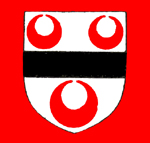Bassets Manor Milton Ernest

Barony of Bedford
Volume III of The Victoria County History for Bedfordshire was published in 1912. The work gave detailed histories of every manor in the county. The Domesday Book of 1086 tells us that the parish was then divided into six separate holdings. Bassets Manor derives from a holding of two hides, less one virgate, held by William Basset from his overlord Hugh de Beauchamp, later created Baron of Bedford.
The overlordship remained with the Barony of Bedford until the death of John de Beauchamp at the Battle of Evesham in 1265, fighting for the rebellious Earl Simon de Montfort against King Henry III (1216-1272). His property was then divided amongst his three daughters, one of whom was Ida de Steyngrave. Her daughter Isabel married Simon de Pattishull and, on his death, Walter de Teye. Her heir was her son John de Pattishull, whose son William died in 1360 leaving four sisters as co-heirs.

Pattishull family coat of arms
The first tenant to be identified after 1086 is Robert Basset who was holding it from the barony in 1252. In 1302 the tenant was Sibyl Basset, as part of her dowery showing that she had married into the Basset family, and by 1330 the tenancy was in the hands of Nicholas de Wortele or Wettele, perhaps Sibyl's second husband. By 1372 the tenancy had reverted to the Basset family, perhaps to a son of Sibyl's by her first marriage. When Sir John Basset died in 1372 he had 120 acres or arable, 8 acres of meadow and 4 acres of pasture in Milton Ernest as well as reversion of 40 acres of land he had granted to Norman and Katherine Basset as tenants for their lives.
Sir John's son John died a year after his father and the manor passed to his sister Alianor, wife of John Barle on whose death the manor seems to have been divided, perhaps among John's daughters, because in 1414 half of it was quitclaimed by John Martyn and John Sampson to Robert FitzRobert and William Babyngton and in 1415 the other half was quitclaimed by Sir John Stanley to William Penythorn, William Anable and others. The half quitclaimed in 1414 seems to have passed to Nicholas Ryggley by 1432 as he quitclaimed it to Penythorn and Anable who thus now held the whole of it. Penythorn placed the manor in hands of trustees to settle it upon himself, his wife and son but after his death they refused to do this so the son petitioned for redress.
Following this the history of the manor cannot be traced for about a century and by 1560 it appears, once more, to have been divided as Richard Styrop quitclaimed a quarter of it to Thomas Rolt and in 1568 another quarter was leased by Rolt for sixty years to John Dawson with a reversion to John Crispe and Anne, his wife they, in 1574, quitclaiming it to Rolt and, by 1578, Rolt seems to have held the whole manor, settling it on his son John on his marriage with Judith FitzGeoffrey. He also held a third of the Manor of Milton Ernest, which was henceforth held with Bassets.
The Rolt family continued to hold the manor until 1746 when Thomas Rolt conveyed it to John Orlebar of Hinwick Hall and Thomas Clendon of Mears Ashby [Northamptonshire] as trustees for sale [CC17-18]. In 1750 the manor was conveyed to Hugh Campbell of Middlesex and Thomas Wilkinson of Oxfordshire, along with a third of the Manor of Milton Ernest for £6,200.
In 1786 Thomas Wilkinson sold the manor to the splendidly named Jervoise Clarke Jervoise of Middlesex [CC40-41]. Jervoise immediately conveyed the manor to Samuel Boyden for £5,500 [CC42-44]. Mary Boyden, Samuel's sister, in her will of 1816 devised the manor to Edward Knight and Richard Richards as trustees [CC45]. Knight then devised his share of the trusteeship to Richard Richards, Rowland Evans and John Evans [CC45], a codicil altering this to a devise to Mary Evans, remaidner to Rowland Evans, remainder to Dinah and Mary Donne.
The manor was later divided into thirds and one of these was conveyed to Philip Booth in 1845 [Z951/1/6]. He ran into debt and his third of the manor was conveyed to Saint Pierre Butler Hook in 1852, then in 1853, to Benjamin Helps Starey for £17,000 [Z951/1/6]. Starey then sold to farmer William Henry Gibbins in 1873 for £17,500 [Z951/7/2]. This third was itself subsequently subdivided and part ended up in the hands of the Lord Ampthill. Bedfordshire and Luton Archive and Record Service does not have any indication of the fate of the remaining two thirds